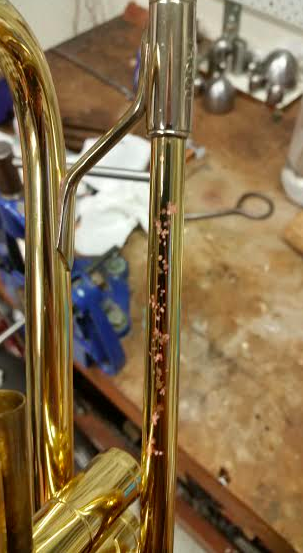The term ‘red rot’ is thrown around without clear understanding and often people associate any red discolouration on a brass instrument to be red rot. I’d like to debunk some of the myths associated with red rot and give a clear explanation and cause of the phenomena.
First off, what is “red rot”?
Red rot describes the corrosion of brass, much like rust with iron and steel. It is red (or pink) in colour, and it is the structural deterioration of the brass that is deeper than the surface – hence ‘rot’.
Understanding the cause of red rot requires a basic knowledge of the metallurgy of musical instrument brass.
What is brass?
Brass is an alloy of copper and zinc, two non-ferrous metals. Brass is made with varying percentages of copper and zinc:yellow (72/28), gold brass (85/15) and red brass (90/10) copper and zinc, respectively.
These can vary in proportions — these are from a world renown bell maker.
Why does red rot occur?
The chemistry and exact mechanism of red-rot is a little complicated. It is dependent on environmental factors such as player’s body chemistry, acid and bacteria. The alloy is also a very significant aspect since alloys higher in zinc proportions are more vulnerable to ‘red-rot’.
Red rot is more commonly seen in horns lacking regular general maintenance and servicing requirements (see: ultrasonic cleaning). The copper in the brass corrodes and forms all the beautiful colours you see down your lead-pipe (green, blues, white and other rare species!) causing the zinc to ‘leak’ from its lattice. It is often known as the dezincification of brass.
As the zinc leeches from the brass, it leaves behind the copper that is now structurally weak and brittle. This is the red colour that is apparent and gives ‘red’ to the phenomena. The
Now, just because you see red on your trumpet does not make it red rot. Surface decomposition is normal for regular use and it will just polish away. Red rot is when the the dezincification is extensive and the zinc is leeching all the way through. This means holes are gradually being worked into the instrument causing it to leak.
How can I tell it is red rot and not just surface erosion?
Red rot is often characterised as a circular point on an instrument, with a dark pin-point in the centre. A good indication is to identify this circular imperfection on the outside of a trumpet leadpipe, for example, and to see if there’s any corresponding defect on the inside of the tube.
Red-rot is a lot more common in the leadpipes of instruments or tuning-slides, since these are the first points of contact of an instrument and often accumulate the most significant amount of corrosion.
Where is it most likely to occur?
Often narrow tube networks such as lead-pipes, and tuning slides. These are the first points of contact of an instrument and often accumulate the most significant amount of corrosion. It can also occur in large bows, but I can explain why these places are susceptible.
Different types of brass also have varying susceptibility, as stated.
The higher the proportion of zinc in the alloy, the more susceptible to red rot it is. So, yellow brass is the most susceptible to red rot because of its 28% content of zinc.
Another place red rot can attack are seams. The seams of saxophone necks and bottom bows can erode after years of playing and/or neglect and these places will crack causing them to no longer be air-tight.
The seam is joined/’welded’ with a brazing alloy known as spelter, and this alloy contains a higher zinc content than the instrument’s brass alloy to lower the melting point to allow manufacturers to braze the seam together without melting the parent material. Since this brazing material is higher in zinc, it is the most susceptible place for the dezincification to occur.
What can be done to remedy the issue?
Some people may tell you its possible to fix red rot through different chemical procedures or a ‘secret’ process a technician has worked out. The fact is there’s no way to fix red rot and any coating of the bore is going to alter an instrument’s tone. There are ways to fix it, but with compromise.
It can only be prolonged through regular maintenance so a tube or seam will not fail. Ultimately, the part must be replaced. Often a sensible solution for replacing a part on an instrument is to use brass with less proportion of zinc, nickel or even stirling silver if a player’s body chemistry does not agree with the brass.
Routine maintenance done at home and professional servicing have proven to be the best strategies for ensuring your instrument a long-life full of playing.


